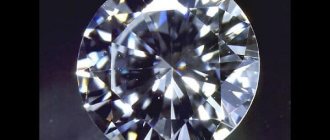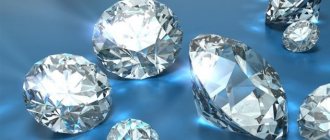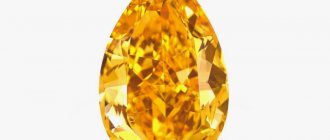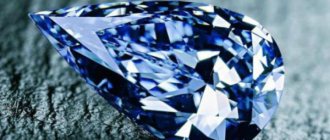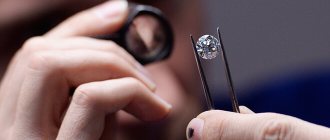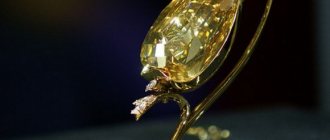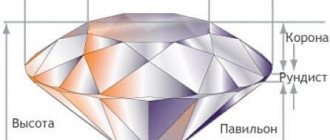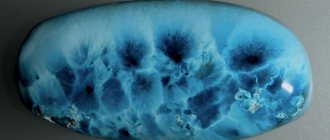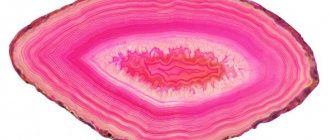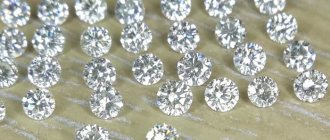| Stone type | Precious |
| Prevalence (Deposits) | Widely spread |
| Varieties | Verp light, Wisselton, Crystal, Light Brown, River, Top Wisselton, Top Cape, Top Crystal, Yater |
| Transparency | Transparent |
| Shine | Glass |
| Mohs hardness scale | 10 |
| Chemical composition | WITH |
| Color | Colorless, blue, yellow, green, brown, red, orange, pink, gray, black |
| Owner's color type | Winter summer |
| Owner's temperament | Choleric |
| Names | Venus, Daria, Ivan, Ilya, Inna, Christina, Leo, Maria |
| Zodiac sign | Leo, Aries, Sagittarius |
| Date of Birth | from March 21 to April 19 from July 23 to August 21 from November 22 to December 21 |
| Chinese horoscope | Rat |
| Element | Fire |
| Planet | Not found |
| Day of the week | Monday, Friday, Saturday, Sunday |
| Month | April, October |
| Season | Spring, autumn |
| Numerology vibration | 4, 6, 9 |
| Chakra | Sahasrara |
| What stones is it compatible with? | Agate, amethyst, white pearl, beryl, turquoise, emerald, coral, lapis lazuli, sapphire, carnelian |
| What stones is it not compatible with? | Malachite, onyx, obsidian, sardonyx |
| Therapeutic effect (problems) | bad habits, immunity, nervous disorders, rejuvenation, stress, phobias and groundless fears |
| Therapeutic effect (on organs) | Skin, respiratory organs, gastrointestinal tract organs, cardiovascular system, joints |
| Magic properties | Difficult life situations, self-confidence, strengthening relationships |
If a person sees a diamond for the first time, it will be difficult for him to believe that it is a diamond, since in nature it looks dull and faded.
Only after cutting and polishing does the nugget turn into a transparent crystal that captivates with its deep radiance. There are many stories and legends associated with the “king of stones”; he has been called indestructible since ancient times. Now diamonds are an object of admiration and attract the attention of the richest people. Diamond has outstanding healing and magical properties. Those who are planning to purchase diamond jewelry should know how to determine its quality and distinguish it from a fake. And if the storage rules are followed, the magnificent crystal will delight its owner with its beauty for a long time.
History and meaning of the diamond
The ancient Greeks called diamond - ἀδάμας, which translated means indestructible or invincible. The first nugget was found in India 6000 years ago. However, people were not impressed by the appearance of the diamond as it looked unattractive. The cloudy-transparent stone gained popularity later, when they learned to process it.
This is interesting! The stone was first cut and polished by Louis de Berquin (Burgundian jeweler) in the 15th century. To do this, he used diamond powder mixed with oil.
Gradually, the technology of stone cutting improved, new processing methods appeared, and already known ones were improved. In the 17th century, diamond jewelry became especially popular. This is due in no small part to the jewelers from Amsterdam and Antwerp, who made all the edges of the crystal flicker with light. After this, the fame of the diamond spread throughout the world, captivating the hearts and thoughts of many great people. To this day, the beauty of cut diamonds amazes.
View this post on Instagram
The unmatched appeal and sparkle of diamonds fascinates people. Here are 15 interesting facts related to these stones: ? Diamond is a stone for those born in April? Shimansky My Girl is the first cut from South Africa to be awarded a foreign patent? It is customary to give diamonds for tenth and sixtieth wedding anniversaries. ? Diamond revenues enable all children in Botswana to receive free education up to age 13. ?. About 10 million people in the world depend on diamond-related jobs. ?. About 65% of the world's diamonds are mined in Africa. ?. The ancient Greeks and Romans considered diamonds to be the tears of the gods. The Romans claimed that Cupid's arrowheads were made of diamonds. ?.In the Middle Ages, diamonds were believed to have mystical powers against many diseases: from insanity to depression. ?. The diamond engagement ring was first presented in 1477 by Archduke Maximilian of Austria to his future bride, Mary of Burgundy. ?. The tradition of wearing an engagement ring on the ring finger of the left hand originated in Egypt. The inhabitants of Egypt believed that the “vein of love” ran from the upper end of this finger straight to the heart. ?. The true Hearts and Arrows cut is the Eight Heart: when viewed through the Ideal Scope, it shows a pattern of eight perfect hearts on the bottom edges and eight perfect arrows on the top edges. ?. The origin of the term "carat" is related to the seeds of the carob tree. Due to their almost constant mass, they were a popular unit of measurement in ancient times. ?. Natural fancy colored diamonds are formed in the presence of trace impurities such as nitrogen or boron. Red and green diamonds are the least common. Less rare are blue, pink and yellow. ?. Only one diamond in a million weighs one carat or more. To extract a one-carat diamond, you need to process an average of 250 tons of ore. ?. Diamond conducts heat four times better than copper.
A post shared by JEWELER MOSCOW? Denis Ursan (@denis_ursan) on Feb 15, 2021 at 9:35am PST
Pitt ("Regent")
Photo: Commons.wikimedia.org
The fate of this stone, also known by two names, is so exciting that it could become the plot of an adventure novel. A huge diamond, weighing 410 carats, was found by a slave in a mine in South India in 1701. To hide the treasure, the poor fellow had to cut his thigh and place a stone in the wound; Later, he agreed with the captain of a British ship to escape, promising him half of the proceeds from the sale of the diamond for his help. However, the sailor did not keep his word: as soon as the ship left the port, the former slave was killed and his body was thrown into the sea. Arriving in Madras, the Englishman sold the jewel to the commandant of Fort St. George, William Pitt .
Question answer
Everything you wanted to know about diamonds.
Infographics Upon returning to England, the former commandant gave the diamond to a London jeweler for cutting - work on the stone took more than two years. By the way, the fragments remaining after cutting the diamond were subsequently composed in the shape of a rose and presented as a gift to the Russian Emperor Peter the Great . After receiving the diamond back, Pitt lived for several years in constant fear that his treasure would be stolen. In the end, he sold it to the regent of France, Philip II of Orleans, for a fabulous sum at that time - 135 thousand pounds.
After him, the diamond was worn (on a bow or tiara) by Louis XV , Louis XVI , Marie Antoinette ; During the French Revolution, in 1792, the “Regent” was stolen from the Palace of Versailles - agents of the Republican government searched for it, and a year later the stone was found. According to some reports, the Republicans pawned it to the wealthy Moscow merchant Treskov General Bonaparte bought the diamond back . Be that as it may, in 1804 he decorated Napoleon's sword at his coronation; the emperor also used the "Regent" as collateral to secure military campaigns.
In 1887, the Regent was transferred to the Louvre, where it was exhibited until the German invasion of France in 1940. Out of fear that the invaders might steal the diamond, at the outbreak of war it was secretly taken to the Chateau de Chambord and hidden behind the marble fireplace panel; There he remained until 1945. Currently, "The Regent" is again exhibited in the Louvre.
Expensive stones. Interesting details from the life of diamonds.
More details
Top 10 largest and most expensive diamonds in the world
Some diamonds have become popular due to their history, others due to their value, and others due to their incredible size. Experts have compiled a list of the largest gems in the world:
- The Millennium Star is a pear-shaped, colorless, faceted diamond that has 54 facets and is ranked 10th. Its weight is 203.04 carats. Found in Congo in 1990.
- The Red Cross is a yellowish cushion-shaped diamond that weighs 205.07 carats. Ranked 9th. Place of extraction: South Africa (1901).
- De Beers is a pale yellow gem that weighs 234.65 carats. This copy is in 8th place. Found in Kimberley in 1888.
- The Jubilee is a clear diamond that weighs 245.35 carats. It was found in South Africa (1895). Takes 7th place.
- Century is a rare transparent crystal, weighing 273.85 carats. This is a South African specimen that was found in 1988. He rightfully takes 6th place.
- The spirit of de Grisongo is the largest black diamond, which is set in white gold and studded with miniature
diamonds. Its weight is 312.24 carats. It is in 5th place. - Cullinan II is a smaller fragment of a larger gemstone, weighing 317.4 carats. Takes 4th place.
- The Incomparable is the largest brown diamond, weighing up to 407.48 carats. It is in 3rd place.
- Cullinan I is a larger fragment of a huge diamond, it weighs 530.2 carats. It rightfully takes 2nd place.
- The Golden Jubilee is the largest diamond in the world, weighing 545.67 carats.
There are other equally famous diamonds. These include the “Heart of the Ocean” - a large sapphire-blue diamond, which is shrouded in many ominous legends. It was believed that it brings death to its owners. And the largest colorless diamond, the Great Mogul, which was found in India, disappeared in 1747. There is an assumption that an equally famous exhibit was obtained from it - “Kokhinur” or “Orlov”.
Cullinan (Star of Africa)
Diamond Cullinan before processing.
Photo: Public Domain The world's largest diamond was mined in the former British colony of Transvaal (now a province of South Africa) in 1905. The stone was discovered by pure chance: the manager of one of the mines at the Premier Mine, Frederick Wells , who went out at night to get some fresh air, noticed a point on the wall of the quarry flickering in the moonlight. Soon, workers extracted a giant diamond weighing 621 grams (3,106 carats) from the rock. Interestingly, scientists later determined that the stone, named Cullinan (in honor of the mine owner; after cutting - “Star of Africa”), was only a fragment of a much larger mineral. But even after shoveling the entire mine from top to bottom, “father” Cullinan was never found.
The Transvaal government soon decided to present the diamond to King Edward VII . However, the question arose: how to safely transport the jewelry to England? At that time, its value was 8 million pounds (or 94 tons of gold) - and Cullinan was perhaps the most desirable prey for the raiders. The British did something clever: they equipped a warship full of armed guards, in the hold of which there was a massive safe; the ship's departure was widely covered by the press. However, the safe was empty. In fact, the stone was delivered by an ordinary mail ship in an inconspicuous package. Only the senders and recipients of the diamond knew about the priceless cargo.
lapidary in Europe, Joseph Ascher was invited to process it : he studied the stone for several months before starting work. When the jeweler put a chisel to Cullinan for the first time and hit it with a hammer, he lost consciousness from excitement.
Properties
Thanks to its powerful energy, the diamond has strong healing and magical properties. It is believed that this stone treats mental illness, helps with diseases of the gastrointestinal tract, respiratory organs, and rejuvenates the body.
Important! The inner magic of a diamond is strong, but it can harm some people. It endows a person with its qualities: strength, hardness, indestructibility. However, it is better for people with unclean thoughts to avoid diamond, as it will only harm them.
Magical
Precious diamond jewelry is ideal for strong, determined and noble people. If a person is evil, then the diamond will attract bad luck to him.
Be sure to see: Types, colors and magical properties of garnet stone
Magical properties of a diamond:
- Protects you from troubles and helps you achieve your goal faster.
- Enhances the best qualities of a person, helps to achieve success in all endeavors.
- Increases vitality, helps avoid diseases.
- Strengthens family ties and makes the owner more communicative.
- Makes a person more attractive in the eyes of the opposite sex, helps to find love, build a family.
To energize a diamond, rub it in a good mood, imagining it filling with light. To improve your mood or gain vigor, follow the same procedure, only now imagine how light comes from the stone into your body.
Medicinal
According to lithotherapists, a diamond heals the human soul, that is, the psyche. It helps to get rid of phobias, nervous disorders, stress, painful addictions (alcoholism, smoking, gambling, drug addiction), etc. The gem normalizes sleep, gives inner harmony and confidence in one’s actions.
Diamond helps reduce fever, reduce pain, speed up recovery from various infections, for example, respiratory diseases, hepatitis. It can be used as part of complex treatment of pathologies of joints, skin, and genitourinary organs. The crystal improves the functionality of the nervous system and the heart.
Diamonds help rejuvenate the body. It is also a strong talisman for mother and child. A woman who is planning a pregnancy should wear jewelry with a crystal, then she will be able to get pregnant faster and give birth to a healthy baby.
It is believed that the mineral improves metabolic processes, gives vitality, and helps to avoid vascular diseases.
View this post on Instagram
DIAMOND? . What he really is? This is a cut diamond. But before a diamond is cut, it is just a stone and its value is small. Even the largest and most expensive diamond is of little value if its edges are not sufficiently polished. . Every stone, like every person, has its own history. What makes a diamond so valuable? . For a stone to sparkle in all its splendor, the talent and skill of a jeweler is required. Sometimes a Master can spend more than one month, and sometimes several years, processing one diamond in order to create a masterpiece that will be admired for centuries. . Become the JEWELER of your life! . And I, as a mentor, coach, teacher, will help polish the edges of your talent and your individuality. . Write!
A post shared by ONLINE YOGA: 7 YEARS TEACHING (@_katerina_sky) on Oct 31, 2021 at 9:51am PDT
Physical
Diamonds are mined from igneous rocks, meteorites or impactites (formations that formed where a meteorite hit the ground). The composition of the stone is surprising in its simplicity - it is pure carbon. In addition, it may contain impurities of nitrogen, silicon, calcium, aluminum, etc. These inclusions affect many characteristics of the crystal, for example, shade, transparency, and ability to accumulate light.
Experts highlight the following physical properties of diamond:
- Formula – C (carbon).
- Color – transparent, yellowish, pink, blue, greenish, brown, sapphire blue, black.
- Mohs hardness – 10 points.
- Density level – from 3.47 to 4.55 g/cm³.
- The fracture is smooth, stepped, conchoidal.
- Refractive index – 2.417.
- The degree of cleavage perfection is high.
- The system is isometric (cubic).
Be sure to see: Origin, properties and compatibility of aquamarine
Due to its strong dispersion and high refractive index, the diamond has a pronounced shine and plays different colors in the light.
This mineral is resistant to many negative factors; it is oxidized only by a chromium mixture at 200°, and melts at 4000°.
The extraordinary properties of diamond
Gold ring with diamond
In ancient times, diamonds were credited with a variety of amazing properties.
Even modern experts note the incredible energy of this mineral.
Its effect on the human body was often used to get rid of various ailments, both physical and mental.
They are still used in the following areas of medicine:
- With the help of these gems you can solve heart problems. The stone will help normalize the functioning of blood vessels and heart muscle, and reduce blood pressure.
- Iridescent crystals have a positive effect on those people who have mental problems. The impact of the stone will relieve stress, calm the nerves, and help normalize sleep.
- The energy of the stones also has a good effect on women’s health, helping to recover from a number of gynecological problems.
- The mineral is also famous for its anti-inflammatory properties. With its help you can cope with dermatological problems. Have a general strengthening effect on all internal organs.
To feel the healing power of the stone, you can put the crystal in water for 24 hours, and then drink this diamond infusion, which can strengthen the immune system and give tone.
Varieties
There are many types of diamonds that differ in color. Transparent crystals are very rare. The shade of a gem depends on impurities, for example, nitrogen, zinc, boron, titanium, etc.
Important! When choosing jewelry with diamonds, you need to pay attention to their purity (clarity). This is an important characteristic that will help you purchase a quality crystal.
Diamond color
Diamonds can be clear or colored. Colorless ones are rare in nature, as are saturated colored gems, and crystals with muted shades are the most common.
Diamonds come in yellow, blue, pink, orange, red, green, brown, gray and black. The most common types of diamonds found in nature are:
- blue with a white tint – yater;
- transparent with a slight bluish tint – river;
- transparent with a white tint – Wisselton top;
- white - Wisselton;
- transparent with a yellowish tint – crystal top;
- yellow color - crystal;
- cognac – verp light;
- transparent honey – top cape;
- light brown - light brown, etc.
Blue, blue, violet or gray diamonds are extremely rare in nature. They are called fantasy crystals, and such crystals are very expensive. Pink gems are also in great short supply, which invariably affects their cost. The more intense the color, the higher the price.
Diamond Clarity
There is a classification of diamonds by clarity; this parameter can be indicated on the product tag with letters and numbers or simply numbers. To assess clarity, the GIA system is used, according to which there are 11 classes indicating the purity of the crystal. Also for this purpose, the Russian system is used, which takes into account not only the number and size of defects, but also the weight of the gem.
Diamond purity according to the Russian and American scales:
| Russian system | GIA | Characteristics of stone purity | |
| Diamonds up to 0.29 carats | Stones over 0.29 carats | ||
| 1 | 1 | IF | There are no inclusions at all |
| 2 | 2 | VVS1 | There are up to 3 small light defects that are difficult to distinguish under a magnifying glass |
| 3 | 3 | ||
| 4 | VVS2 | ||
| 4 | 5 | VS1 | About 3 dark inclusions, up to 6 light ones. They are small and only visible through a magnifying glass. |
| 5 | 6 | VS2 | |
| 7 | SI1 | Up to 8 defects of any color that can be seen through a magnifying glass; a specialist will examine them with the naked eye | |
| 7a | SI2 | ||
| 6 | 8 | SI3 | |
| 9 | I1 | A large number of inclusions that are noticeable even without a magnifying glass. There are also cracks | |
| 7 | 10 | I2 | |
| 8 | 11 | I3 | |
| 9 | 12 |
It is recommended to buy diamonds whose clarity is at least SI3 on the American scale.
The magical properties of diamond
Diamond ring
Diamond stone: properties, who it suits according to their zodiac sign and how to wear it?
The diamond also actively exhibits magical properties. It becomes a powerful protector of its owner, protecting him from any negative influence from the outside.
In ancient times, rulers always took a diamond with them to feasts, knowing that it could prevent poisoning.
It can give a person with pure thoughts self-confidence, well-being in his personal life, and success in his career.
It has been used since ancient times to perform magical rituals. A yellow-colored stone is especially effective in this case.
The red crystal is so powerful that not everyone can control it. But white can become a talisman for any person.
It will reveal its qualities if you combine it with gold and wear it on your left hand. The ring gives men luck in the game and success with women.
Beautiful earrings or necklaces will add charm to ladies and help them find love.
The stone will most actively reveal its power to Aries, but Pisces are better off choosing another talisman.
Diamond cut
The cut of the crystal is another important parameter that gives it a special radiance, as well as the play of light. What it will be depends on the initial shape of the diamond. And the cutter must preserve the weight of the stone as much as possible during work. Then the ennobled gems will look amazing.
Types of diamond cuts:
| Name | Characteristic |
| Round cut | This diamond consists of a crown (top), girdle (middle wide part) and pavilion (bottom) and has 57 facets. Gives the brightest shine |
| Marquis | This is a boat-shaped wedge cut crystal. Can be used separately or complemented with a scattering of gems |
| Pear | This is a teardrop-shaped diamond. Often used for insertion into pendants and earrings |
| Oval | This is an oval shaped stone. This shape is most often used for cutting large gems. |
| Princess | This is a square-shaped wedge cut that has sharp corners. Has a high degree of radiance and play of light |
| Emerald | This is a step cut in the shape of a rectangle, which has truncated corners. |
| Asher | It is a variation of the previous cut, but in the shape of a square and with more tiers. |
| Radiant | This is a wedge cut square or rectangular cut diamond with an octagonal outline |
| Heart | Wedge-shaped gem with a heart outline |
Triangle and baguette cut diamonds are also available.
Diamond in the old days: what was it called
In many crossword puzzles there is a question about how the name of the hard precious material sounded. The answer must be 7 letters long. In this regard, most mineral lovers want to learn more not only about the origin of the products themselves, but also about the etymology of the word itself.
In order not to languish you while waiting for an answer to the crossword question, we will immediately give the answer: the outdated name will be adamant. This is exactly what in Rus' ordinary and noble people called what is now called diamond.
You will be interested to know that adamant used to be called not only a pretty pebble that shimmers under the rays of sunlight. This name was also applied to a person distinguished by strong views and a decisive character.
Where does the word "diamond" come from?
Since precious stones have gained popularity quite a long time ago, it is very difficult to find out what the history of the origin of the name of the material is. There are several versions about what word the name “diamond”, which is familiar to us today, comes from. Most philologists of the ancient Greek language agree that it has its origins in the Greek language - "adamas", which literally means "indestructible".
At that time, this word was applied to the material that was the hardest. In ancient days, corundum (a type of sapphire) was considered the most durable material, so this Greek designation was applied either to it or to other solid substances. If now this “name” is given to a certain stone, then in the days of Pliny adamas was the name given to various minerals that were distinguished by high levels of hardness.
When they called “adamas” in Ancient Greece, it became clear to everyone that we were talking about an incredibly beautiful stone that was worthy of becoming an adornment for the richest royal family. The name of the mineral spoke of the high position of its owner.
Where did “diamond” come from?
Today the words diamond and diamond are synonymous, and there is a semantic explanation for this. The fact is that these two words come from different words in Greek and Latin, but have a similar sound.
Diamond comes from the Latin "adamantem" (sounds like the Greek adamas, doesn't it?). The way the name is written speaks to the belief of our ancestors that this type of stone can withstand any blow. In practice, everything is not so, because even the most durable emerald is not able to resist a strong blow from a hammer or other heavy tool.
A more appropriate word for a precious object would be the Portuguese word "carbonado". It has the meaning “carbonaceous,” which appropriately reflects the dense counterparts of the Brazilian specimens.
We really hope that you found our article interesting and useful. Surely you liked reading about where they first began to use the familiar name for the most popular jewelry in the world. The ancient name will always remind you of such features of the stone as its hardness and “indestructibility”.
If you would like to share this information with your friends, you can use the social media buttons located at the bottom of the site. Telling your friends about what diamonds were called in the old days can help them broaden their horizons.
Diamond grading system 4C
During the expert assessment of a diamond, the following criteria are taken into account:
- Weight of the stone in carats.
- Crystal color.
- Diamond clarity.
- Quality of cut.
The weight of an unmounted gem is determined on a carat scale. If the crystal is already mounted, then the carats can be approximately determined by the following formula: M (carat weight) = D² (diameter) x H (height) x 0.0061. To determine the carat of a stone with a thick middle part, the coefficient of 0.0061 is increased by 0.0067.
Transparent diamonds are considered the most valuable. The most common crystals are those with yellowish or brown tints. Fancy colored diamonds are rare in nature.
As mentioned, clarity and cut have a big impact on the quality of the stone.
Important! 1 carat is equal to 200 mg. The mass of the crystal is determined with an accuracy of 0.01 carats.
According to the number of carats, diamonds are divided into the following groups:
- crumbs – up to 0.01;
- small – about 0.029;
- average – from 0.03 to 0.99;
- large - from 1 carat.
The weight of diamonds of the same diameter differs depending on the cut. To convert the size of a round diamond into carats, you need to use the following table:
| Diameter (mm) | Weight (carats) |
| 4.1 | 0.25 |
| 5.1 | 0.5 |
| 6.4 | 1 |
| 8.2 | 2 |
| 9.4 | 3 |
| 10.4 | 4 |
| 11 | 5 |
| 14 | 10 |
| 16 | 15 |
Carat and diameter of Asscher or Princess cut crystals:
| Circumference (mm) | Weight (carats) |
| 3.3 | 0.2 |
| 4.45 | 0.5 |
| 5.55 | 1 |
| 7.05 | 2 |
| 8.05 | 3 |
| 8.85 | 4 |
| 9.5 | 5 |
The ratio of weight and diameter of fancy-cut crystals:
| Cut type | Dimensions (mm) |
| Marquis | 9.8x5.6 |
| Pear | 8.6x5.8 |
| Heart | 6.7x6.5 |
| Emerald | 6.4x4.9 |
| Oval | 7.7x5.9 |
To accurately measure the weight and evaluate a diamond, you need to contact a jeweler.
Who would you trust to buy diamonds?
For a specialistOnly for yourself
Diamond Categories
The cost of a cut stone directly depends on four parameters - the color of the diamond, its clarity, quality of cut and carat (weight, 1 carat = 0.2 grams). The higher all these indicators are, the more expensive the diamond is valued. Unique characteristics are not found very often, and such clean, perfectly cut stones, each in its own category of color and weight, are auction items and are found in private collections. The cost of diamonds in this category amounts to hundreds of thousands and tens of millions of dollars.
Jewelers use the 4C rule to evaluate stones: Carat/Color/Clarity/Cut – weight, color, transparency (purity), cut. Each category has its own characteristics, and they are not always clear to everyone who is far from the jewelry profession. But even the basics that allow you to understand the value of diamonds will be enough to choose and buy any other jewelry with a diamond that has a truly decent value.
Diamond carat
In the ancient times of the Ancient East, when the equipment available to modern masters of precious stones and metals could not even be dreamed of, the weight of diamonds, like other stones and even food products, was compared to the seeds of the carob (Caribbean) tree. Ceratonia capita in Latin has a name consonant with the word “carat” - cerátiοn. The stable mass of these seeds, equal to 0.2 grams, became a measure of weight, among other things, for diamonds.
One such grain is the equivalent weight of a diamond of 1 carat (Ct). But a diamond, even a faceted one, has a special property: stable, unchanging density. This quality became the basis for grading the carat of diamonds according to their diameter (or width in millimeters). You can measure these values and correlate them with the carat table, the values will be identical, and the differences will be tiny and meaningless.
For diamonds weighing more than 1 carat, this rule applies in the same way; the ratio of the diameter of the stone and its weight can always be compared with the data in the table and the results of weighing on special equipment - there will either be no discrepancies at all, or their presence will be reduced to a slight minimum.
The joke that a real woman can determine the carat value of a diamond by eye without a scale is not a joke at all. The photo clearly demonstrates the relationship between size and carat weight, assuming the diamond is on the finger.
Of course, remembering all the sizes is not so easy. But for fans of diamond jewelry, there is a proven life hack:
- if you take as a basis the smallest diamond, half a carat, and the largest, 7 Ct, and also remember how a 3-carat stone looks on your hand, all other intermediate values can be determined by focusing on the larger and smaller sides of the average size.
It is worth remembering that this data can only be applied to diamonds, the data is derived relative to their density. This system is not suitable for sapphires, rubies, topazes and other precious stones. Visually, a 1 Ct diamond and, for example, a ruby will be different sizes; corundum is noticeably larger than a diamond with equal carat stones.
Diamond color
To distinguish diamonds by color, a universal international designation system has been developed using the GIA (Gemological Institute of America, an independent organization) method, where the gradation is designated by the letters D to M.
Colorless diamonds are the most expensive on the jewelry market; these are stones of categories D, E and F. Understanding the difference between stones of this highest category is the work of a specialist with extensive experience. Such diamonds belong to the investment group and are used in exclusive jewelry or for storing and increasing funds. The cost of such stones increases by 10% annually.
GH is the second category, such diamonds are also quite valuable, but have a lower price due to a barely noticeable yellow tint.
All other diamonds, from I to Z, belong to the group of inexpensive colorless stones and are most widely used in jewelry.
In addition to the international GIA system, there is a Russian gradation: it is more complex and is designed primarily for professionals - jewelers, appraisers.
The color relationship between GIA and Russian parameters depends on the carat of the diamond and for this reason there are some discrepancies between the data of the international and Russian classifications.
Among other things, the Russian scale has developed a color rating system for diamonds with different cuts - 17 facets, 57, and so on. This part of the gradation is needed only by jewelers to certify stones.
Light transparent stones are not the only existing standard; cut diamonds can have different shades and sometimes the usual colorless diamonds are not so interesting and are not valued highly enough against the background of blue, green, pink, and gold shades. Therefore, for all diamonds that have a different color, the Fancy group has been developed - fantasy shades. The darker the color, the higher the cost of such a diamond.
Diamond Clarity
Assessing color without the clarity of a stone is almost pointless; these parameters are interdependent, although it is very difficult to find a stone with an ideal relationship between color and clarity - these are expensive, rare, beautifully cut diamonds. Moreover, only a professional can give an objective assessment of this parameter. Clarity
or transparency - a parameter showing how many defects a stone has and how much these inclusions affect the appearance of the diamond.
Nature has not yet created a single diamond without a single inclusion, and if you see a stone with perfect transparency, in which even the smallest, insignificant defects are completely absent, it is a fake.
As in the case of color, jewelers use the international GIA system and the Russian scale. The GIA scale includes 11 classes, in which defects can have varying degrees of visibility, be located inside the diamond, on its outer surface and, depending on the intensity and location, affect the clarity of the stone. The Russian scale, as in the case of color, is more complex and classifies the clarity of a stone not only by the presence of inclusions, but also in their relation to the weight of the diamond and the number of facets.
The buyer can rely on a simplified purity assessment system presented in the table (the ratio of the letter GIA to the Russian number scale)
It is worth remembering that diamonds of category IF ( INTERNALLY FLAWLESS
) are the rarest, unique stones, the defects of which are reduced to damage to the outer surface that is barely visible even under magnification, provided that they can be reduced by polishing. Such diamonds are the main participants in prestigious exhibitions, the most expensive lots at prestigious auctions at the level of Sotheby's or Christie's.
We are sure you noticed a beautiful blue diamond at the beginning of the article - this is a Winston Blue, a stone of the highest, impeccable purity, weighing 13.22 carats, which was sold during one of Christie's auctions for $24.2 million. A cushion-shaped diamond of the same color, but grade VS2, cost more than $1.8 million per carat in 2013.
Large stones VS1-VS2 are considered very good, worthy under other conditions of auctions, and VVS1-VVS2 are considered expensive, collectible. For the manufacture of jewelry for mass sale, with small diamonds, up to 0.3 carats and a little higher, stones of categories SI 1-SI 2 are used, and for quality products even categories I1-I3 (6-12 positions on the Russian scale) are not used. If you want to buy a good diamond, its transparency should not be lower than SI3 on the GIA scale, that is, 7/7a according to the Russian gradation.
Data about diamonds is indicated on the product tag or in the certificate, and now you can easily decipher the meanings.
Diamond cut
This parameter alone may require a separate, impressively voluminous article, so we will only touch on the most popular types of cuts. In total, cutting methods number in the dozens, and the numbers tend to hundreds of options. But not all are used in modern jewelry - there is no need and, probably, suitable stones. Like all previous parameters, the cut that turns a diamond into a beautiful diamond is judged by its quality. And the main requirement for processing is the creation of geometrically accurate, preferably flawless, edges and their proportions. The number of sides also differs, depending on the style:
- 17 facets - simple type of cut
- 33 – Swiss style
- 57 – classic full Tolkowsky cut
- 73 – “highlight-cut” type (increases radiance)
- 86 – royal cut
- 102 – majestic, only for large diamonds
These forms are used constantly today, and the choice of cut type always depends on the initial quality of the diamond and its characteristics. With the help of the right cut, you can give your future diamond maximum brilliance, and the precise placement of the edges will help hide defects or at least make them less noticeable.
All types and shapes can be divided into three categories - brilliant cut, step cut and mixed cut. Each has its own advantages: for example, stepped
The emerald and asscher cuts are perfect for clean stones and only highlight the natural characteristics of diamonds.
Diamond
cut - one that is based on the principle of best light refraction, can have 57 facets and more. Such stones demonstrate an incredibly bright, multi-faceted shine, and are used in most cases for round diamonds and all where a rectangular or square shape is not required. It is because of the ability to bring out the best characteristics of a diamond and transform it into a beautiful diamond that this form is used more often.
Mixed
cutting is an opportunity to preserve the weight of a diamond, its quality, color; it is successfully used if the stone has a number of flaws that are required and possible to hide, and at the same time emphasize the shine and light reflective qualities of the stone. This method was invented in the middle of the last century in Sri Lanka, and to this day the method is successfully used in princess, radiant, and pear (aka drop) cuts.
Choosing a cut is not an easy matter, and jewelers make a lot of calculations before starting to process a diamond, and the final decision may come months after the first acquaintance with the diamond. Still would! The cut literally decides the fate of the stone: a wrong decision will ruin the stone, turning even a very clean diamond into an unusable diamond with even one imprecise cut.
Application
In most cases, cut diamonds are used to make exquisite jewelry, such as earrings, rings, necklaces, pendants, etc. Jewelry sets look especially luxurious.
The largest and most beautiful gems end up in private collections and museums.
Stones that jewelers consider to be of poor quality are used to make abrasive tools and components. In addition, the mineral is used in nuclear energy, microelectrics, etc.
How to buy a diamond without being scammed
In fact, in the modern world, the diamond sales market has grown into a civilized, well-structured process. All precious stones are accompanied by an official document, which also has legal significance. Diamonds in general sale, presented in jewelry stores, depending on their category, have either a store tag or an appraisal certificate from one of the specialized companies. In Russia, reputation is valued no less than in GIA and is highly respected, including among foreign partners, by more than one company.
Of course, GIA specialists have earned the greatest trust; this institute is not commercial and does not focus on the influx or lack of clients, unlike commercial organizations - such companies often inflate the characteristics of a diamond in order to please the customer.
We have written another detailed review on how to distinguish a real diamond from a fake.
How to wear and clean
In order for a diamond to retain its beauty for a long time, you need to provide it with proper care:
- Keep stones away from cosmetics, chemicals and grease.
- Do not expose diamonds to prolonged exposure to sunlight, as a white coating will appear on their surface, which only a jeweler can remove.
- Store diamond jewelry separately from other items.
- Periodically clean the stones with a cloth soaked in soapy water, then rinse and dry.
- Ammonia or alcohol will help remove fat from the crystal.
At least once a year, take your diamond jewelry to a jewelry workshop for cleaning.
View this post on Instagram
How to choose a diamond based on price and quality ratio❓ Only a specialist can notice the difference between several stones of different shades standing in a row? And looking at an engagement ring with a colorless-looking stone up to three carats, few people can say without guessing whether it is color 2 (E according to GIA) or 4 (G according to GIA). And in some stud earrings, the error in assessing purity may be even greater. Are most of the nuances visible only through a microscope? , so it’s important to decide on size and color, and then experiment with purity. For example, you can save money by choosing a distinctly yellow stone at the end of the color scale, but bet on its size and clarity - will it look like a sparkling drop of champagne? There is one more trick when selecting large stones. Their cost depends on the weight in carats, and the cost per carat depends on the sieving, that is, 0.98 ct. will cost much less than 1.0 ct. and visually the stones will be the same. Naturally, such proposals sell out very quickly. It is extremely difficult to find them on store shelves, especially since some unscrupulous suppliers round them up to an even weight in order to get greater benefits. I hope the information was useful. If you want more, put ➕ in the comments?
A post shared by CUSTOM JEWELRY (@rish_art) on Nov 1, 2021 at 4:38am PDT
Diamond Applications
Diamond stone
The use of diamond is not limited to use in the jewelry industry, where preference is given only to specimens of the highest quality.
The use of diamonds is widespread in a variety of areas, including:
- Medical devices and instruments. In the medical field, the use of transparent crystals is very widespread. Thanks to such devices, which allow thin incisions to be made, healing time in the postoperative period is accelerated. Scalpels made from this material remain sharp for a long time. The structure of diamond makes it possible to use it in the production of implants.
- The high thermal conductivity of diamond makes it indispensable for use in electronics to prevent overheating of devices.
- The properties and composition of diamond explain its use in the field of telecommunications. It is valued for its ability to withstand voltage and temperature surges.
- It is also used in the mining industry to add efficiency to the drill bit.
Interestingly, only 15% of the crystals mined in the world can be cut into diamonds.
About 44-46% are “conditionally suitable” for cutting. The remaining percentage of extracted raw materials is used for industrial and production needs.
How to spot a fake
Diamonds are expensive, so it is important to know how to distinguish a natural stone from a fake:
- Exhale on a stone: an artificial one will immediately fog up, but a natural one will not, since it can dissipate heat.
- Pay attention to the setting and setting: the inside of the jewelry with a real diamond should be marked Plat, PT (platinum), 18K, 10K, 14K and hallmarked. The inscription CZ means that this is cubic zirconia.
- Examine the surface of the stone through a jewelry loupe for defects: a natural mineral almost always has minor defects, but a synthetic one does not.
- Throw a stone into water: a diamond will immediately sink, but an imitation diamond will not.
In addition, the authenticity of the stone is confirmed by a GIA, LGP, PGGL or AGSL certificate.
This is interesting! Also on sale are diamonds grown in a laboratory using special technologies. They are widely used in industry.
Diamond - what is it?
This precious stone is a diamond cut in a special, ultra-precise way: the edges are arranged in such a way that the natural beauty of the stone is emphasized - its color, transparency, light refraction. Jewelers have developed enough types of cuts to find a personal approach to each diamond, a method that will help create a beautiful, shining diamond.
In the buyer’s language, a diamond is a beautiful stone, a symbol of wealth, and in former times, power: only the nobility and royalty were allowed to wear cut diamonds. Of course, a diamond is a win-win gift option. It will never be superfluous, it is unlikely that anyone will refuse such a gift or say “thank you, but I already have it.” There are never too many diamonds, let alone too many, the value of stones only grows over time, and no modern developments in creating synthetic analogues are ready to compete with diamonds.
Main conclusions
Diamonds appeared a long time ago, but did not gain popularity immediately, but only after ancient craftsmen learned how to cut them. The rating of the largest gems, which amaze with their radiance and weight, deserves special attention. Diamonds have powerful energy, so they can be used to treat various diseases, and also as amulets.
When choosing a quality stone, you need to pay attention to its weight, clarity, color and quality. Diamonds are most suitable for representatives of the fire zodiac signs. When choosing a stone, you need to know how to distinguish a natural mineral from an artificial one. In order for the crystal to delight you with its beauty for a long time, you must follow the rules of caring for it.
Share your emotions from wearing diamonds and leave feedback in the comments.
Hope (Blue Frenchie)
The Hope Diamond is on display at the Natural History Museum. Photo: Commons.wikimedia.org/CSvBibra
Although this diamond is the third from the bottom on the list of the largest (45 carats), its mystical history can be the envy of stones from the top ten. There is very little reliable information about it: it is believed that it was obtained by the famous jewel hunter Jean-Baptiste Tavernier during one of his expeditions to India. The French kings Louis XIV and Louis XV sported this rare blue stone, but after the revolution, in 1792, it was stolen - and traces of it were lost until 1839, when it was acquired by the British aristocrat Henry Philip Hope , who gave it its name.
However, “The Blue Frenchman” is interesting not so much for its true facts as for its legend. According to it, each owner of the stone brought upon himself some kind of misfortune: murders, suicides and ruins are allegedly written into his history. For example, one of its owners was Queen Marie Antoinette of France , who famously ended her days on the guillotine. And after the French Revolution, the diamond ended up in England, where it was acquired by a certain jeweler Vaals - legend says that the stone was stolen by his son, who after some time committed suicide. Unable to bear such grief, Vaals himself soon died. The legend also features a Russian prince who gave a jewel to his beloved, and then convicted her of infidelity (both died); a high-society Parisian who died shortly after acquiring the stone; and even the Sultan of the Ottoman Empire Abdul Hamid II , who miraculously escaped from the infernal machine thrown at the doors of the mosque by his opponents shortly after he acquired Hope.
Of course, you should not take the legend seriously: it was invented in 1910 by jeweler Pierre Cartier in order to “raise the price” of the stone, and does not pass the test of facts. Moreover, since 1958, Hope has been quietly stored in the Smithsonian Institution in the USA - and no anomalies have been observed. It is possible, of course, that over the centuries his deadly spell has worn out.

